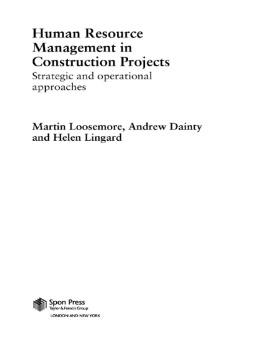
CONTENTS
List of Tables
- Chapter 05
- Chapter 09
List of Illustrations
- Chapter 01
- Chapter 02
- Chapter 03
- Chapter 04
- Chapter 06
- Chapter 07
- Chapter 08
- Chapter 09
- Chapter 10
Guide
Pages
Project Management in Construction
SIXTH EDITION
Anthony Walker
BBS, MSc, PhD, FRICS
Emeritus Professor of Real Estate and Construction
University of Hong Kong
This edition first published 2015
2015 by John Wiley & Sons, Ltd.
1984, 1989, 1996, 2002, 2007 by Anthony Walker
Registered Office
John Wiley & Sons, Ltd., The Atrium, Southern Gate, Chichester, West Sussex, PO19 8SQ, United Kingdom.
Editorial Offices
9600 Garsington Road, Oxford, OX4 2DQ, United Kingdom.
The Atrium, Southern Gate, Chichester, West Sussex, PO19 8SQ, United Kingdom.
For details of our global editorial offices, for customer services and for information about how to apply for permission to reuse the copyright material in this book please see our website at www.wiley.com/wiley-blackwell.
The right of the author to be identified as the author of this work has been asserted in accordance with the UK Copyright, Designs and Patents Act 1988.
All rights reserved. No part of this publication may be reproduced, stored in a retrieval system, or transmitted, in any form or by any means, electronic, mechanical, photocopying, recording or otherwise, except as permitted by the UK Copyright, Designs and Patents Act 1988, without the prior permission of the publisher.
Designations used by companies to distinguish their products are often claimed as trademarks. All brand names and product names used in this book are trade names, service marks, trademarks or registered trademarks of their respective owners. The publisher is not associated with any product or vendor mentioned in this book.
Limit of Liability/Disclaimer of Warranty: While the publisher and author(s) have used their best efforts in preparing this book, they make no representations or warranties with respect to the accuracy or completeness of the contents of this book and specifically disclaim any implied warranties of merchantability or fitness for a particular purpose. It is sold on the understanding that the publisher is not engaged in rendering professional services and neither the publisher nor the author shall be liable for damages arising herefrom. If professional advice or other expert assistance is required, the services of a competent professional should be sought.
Library of Congress Cataloging-in-Publication Data
Walker, Anthony, 1939
Project management in construction / Anthony Walker. 6th edition.
pagescm
Includes bibliographical references and index.
ISBN 978-1-118-50040-8 (pbk.)
1.Construction industryManagement.2.Project management.I.Title.
HD9715.A2W27 2015
624.0684dc23
2014045947
A catalogue record for this book is available from the British Library.
Wiley also publishes its books in a variety of electronic formats. Some content that appears in print may not be available in electronic books.
Cover Image by (building) iStockphoto PPAMPicture
(background) iStockphoto Godruma
Preface
As the sixth edition of this book makes its appearance, the challenge of managing construction projects to successful outcomes continues unabated throughout the world. Prestigious projects make the headlines: both those successful and those less so. The publics imagination is captured by, for instance, constructions to accommodate great sporting events such as the Olympics and spectacular buildings such as Burj Khalifa and Shanghai Tower. But such projects overshadow the enormous amount of construction which contributes hugely to peoples well-being. The importance of developing all projects effectively, both public and private, is central to economy in using the worlds resources. Many factors impinge on success in this arena: development and utilisation of materials and new machines, training and education of a skilled workforce, political will and understanding of peoples needs, to name but a few.
A major need, central to effectively producing projects whatever their scale, is the organisation and management of people skilled in designing and building them. As with all previous editions of this book, this edition focuses further on proposing and using systems theory as the organisational approach suitable for this task and addresses the increasing complexity of the environments within which construction projects find themselves placed. In doing so, this edition has sought to explain how diverse approaches to organisation underpin systems theory and its relevance to construction project management as well as recognising the many competing paradigms and alternative perspectives available, for example in relation to differentiation and integration. Recognition has also been afforded to recent emergence of the study of temporary organisations arising in mainstream management and its relevance to construction project management.
Whilst encompassing the need to develop further theoretical aspects of construction project organisation theory, this edition has also enhanced application of organisation studies to practical issues of construction project management. More emphasis has been placed on the added complexity of construction project management by issues surrounding clients and stakeholders and by issues engendered by control and empowerment of project participants. Additional focus has been made on sustainability issues as they impinge on construction project management, on reworked views on supply chain management and on developments in partnering together with clarification of the shifting terms and definitions relating to construction organisation structures and their uses. Other general updating has been undertaken with some reorganisation of chapters and sections to aid continuity and clarity.
Six editions are not achieved without great indebtedness to colleagues from both academia and practice who have contributed enormously to my knowledge and understanding and who have provided encouragement over many years. I fully recognise their contribution, in particular my colleagues past and present from the University of Hong Kong and those who publish in the academic press in the field of construction project management in its widest sense. And, of course, once again my thanks are due to my wife for seeing me through this edition with forbearance and encouragement. Of course, only I am responsible for any faults that remain, but hope that this edition continues to make a contribution to the field.
Anthony Walker
Hoylake
Introduction
1.1 Introduction
The management of construction projects has been carried out since people first cooperated to erect buildings, yet there is little documented knowledge of how people interacted in this process. It is revealing that historical and contemporary accounts of construction work pay little attention to how people worked together and managed their activities. Writers over the ages have concentrated upon the buildings themselves, particularly on aesthetics, the use of new materials, technological developments and the impact of buildings on their environment. How people were organised and managed received scant attention until recent times. What was written tended to be about such charismatic characters of enormous ability as Brunel and Wren, and not about how they structured their organisations.
Next page





